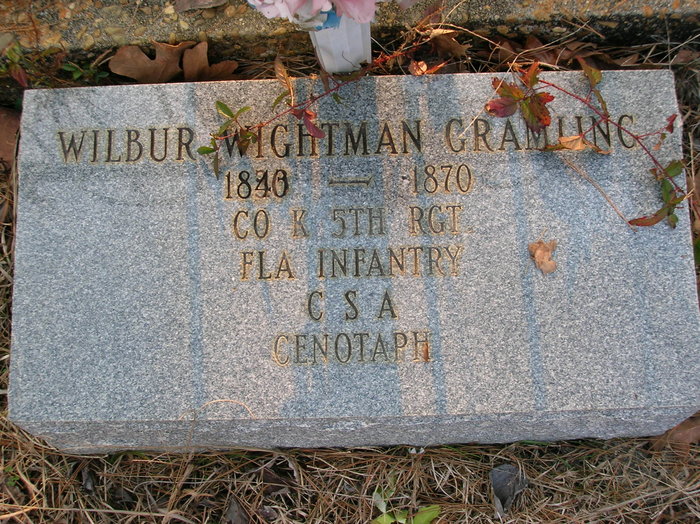The Great Shohola Train Wreck – The Grambling Diary
Posted By Norman Gasbarro on May 23, 2014

Wilbur W. Grambling, a member of the 5th Florida Infantry, Company K (Confederate) arrived at Elmira Prison Camp on 24 July 1864, eight days after the arrival of the first survivors from the Great Shohola Train Wreck. Wilbur had been wounded on 6 May 1864 at the Wilderness, and because he had been sent to a hospital in a Presbyterian church in Fredericksburg, Virginia, 9 May 1864 and then later to the Columbian Hospital, Washington, D.C., on 21 May 1864, he did not travel in the usual way to Elmira Prison Camp – from Point Lookout, Maryland, by steamer to Jersey City, New Jersey, thence by the Erie Railroad to Elmira.
A footnote in an article that appeared in the Chemung Historical Journal, March 1975, in an article “A Rebel’s Diary of Elmira Prison Camp,” by James P. Jones and Edward F. Keuchel, stated:
Of the 4425 prisoners in the camp by the end of July all except Grambling’s contingent had been transferred from Point Lookout on Chesapeake Bay….
The diary of Wilbur W. Grambling was discovered among family papers in Florida 1861 and transcribed by Clifton Paisley of Florida State University, where a copy of the diary now resides. The diary begins on 6 May 1864, the day of his capture and concludes on 5 May 1865. According to military records, Grambling was released from Elmira on oath on 21 June 1865.
The transport of Wilbur W. Grambling‘s “contingent” was by rail – the Northern Central Railroad, from Baltimore to Elmira – and thus he traveled through Millersburg and the Lykens Valley on his way to the Union prison.
On 21 May 1861, Wilbur arrived at Columbian General Hospital in Washington, D.C. He reported the following in his diary:
Arrived at Washington this morning at daybreak. Now in hospital on the north side of town. It is called Columbian Hospital….
His recovery from his wounds complete on 23 July 1864, he wrote:
Left Washington 1 o’clock for Elmira. Arrived at Baltimore at 7. A great many spectators on the street. Got off the cars at Mountain House on Howard Street and turned down Franklin. At Franklin House drew rations and left at 8 o’clock.
The next day, he boarded the Northern Central Railroad, and began his journey north:
Traveled all night and find we are 170 miles miles from Elmira. Corn crops are very sorry. Wheat is gathered. Oats is pretty good. Traveled through Catskill Mountains [sic] up the Susquehanna River. Crossed it 20 times. Got here [Elmira] 6 o’clock.
If Wilbur traveled up the Susquehanna River, he did not travel through the Catskill Mountains – which are located in New York State, north of the Pocono Mountains. Shohola is located in the northern Pocono area and upon crossing the Upper Delaware River, the Catskill Mountains begin in lower New York State – the Susquehanna River is not in that area. Travel by rail (crossing the Susquehanna 20 times, an exaggeration) the only route from Baltimore to Elmira that involved the Susquehanna River was via the Northern Central Railroad – directly through Harrisburg and Millersburg.
On 28 July 1864, he noted the condition of the prisoners who had been at Point Lookout:
About 600 more prisoners came in this morning from Point Lookout…. They are looking bad. Some so poor that they look like it is hard for them to navigate. One-half barefooted.
When Wilbur was released in June 1865, he was given free passage south to his home in Florida. The passage would have been by rail – again, the Northern Central Railroad being the most direct route. Thus, he was one of the only prisoners at Elmira who arrived and was sent home the same way – through Millersburg and the Lykens Valley.
Wilbur W. Grambling was born on 30 March 1843 near Spartansburg, South Carolina. In 1850, his father, Andrew P. Grambling (born about 1808) and mother Elizabeth had moved to Leon County, Florida, where he took up farming. Wilbur had an older brother, Irvin Grambling, who also served in the 5th Florida Confederate Infantry regiment during the Civil War. He also had three older sisters: Margaret Grambling, born about 1835; Martha Grambling, born about 1836; and Jane D. Grambling, born about 1838.
In the 1860 census for Leon County, listed three slaves as owned by A. P. Grambling: A black male, aged 50; a mulatto female, aged 35; and a black female, aged 13. In the census, Andrew Grambling identified himself as a planter. Irvin and Wilbur were both named as farmers.
In the 1870 census for Leon County, Wilbur was the head of the household, working as a farmer, with his brother Irvin and widowed mother Elizabeth also in the household. Interestingly, there were two other white residents in the household – but all the neighbors were black.
According to the article by Jones and Keuchel, Wilbur W. Grambling died on 3 December 1870, in Leon County, Florida, at age 27, from a respiratory ailment he contracted while confined at Elmira. Throughout his diary, Wilbur reported on the weather at Elmira – many days were wet from rain or snow and a small pox epidemic was described on 19 December 1864 (he was vaccinated before 26 December 1864 and the scab fell off on 16 January 1865).
It is impossible to tell from the account of Wilbur W. Grambling how many prisoners arrived at Elmira the same way he did – via the Northern Central Railroad. But, from his diary, it is known that as of the end of July 1864, Wilbur was part of the only contingent to come up through the Susquehanna Valley, avoiding the Point Lookout ferrying by steamship to Jersey City and the Erie Railroad trip through Shohola.
———————————–
For a listing of all other posts in this series, with direct links, click on ShoholaTrainWreck.
 ;
;




Comments